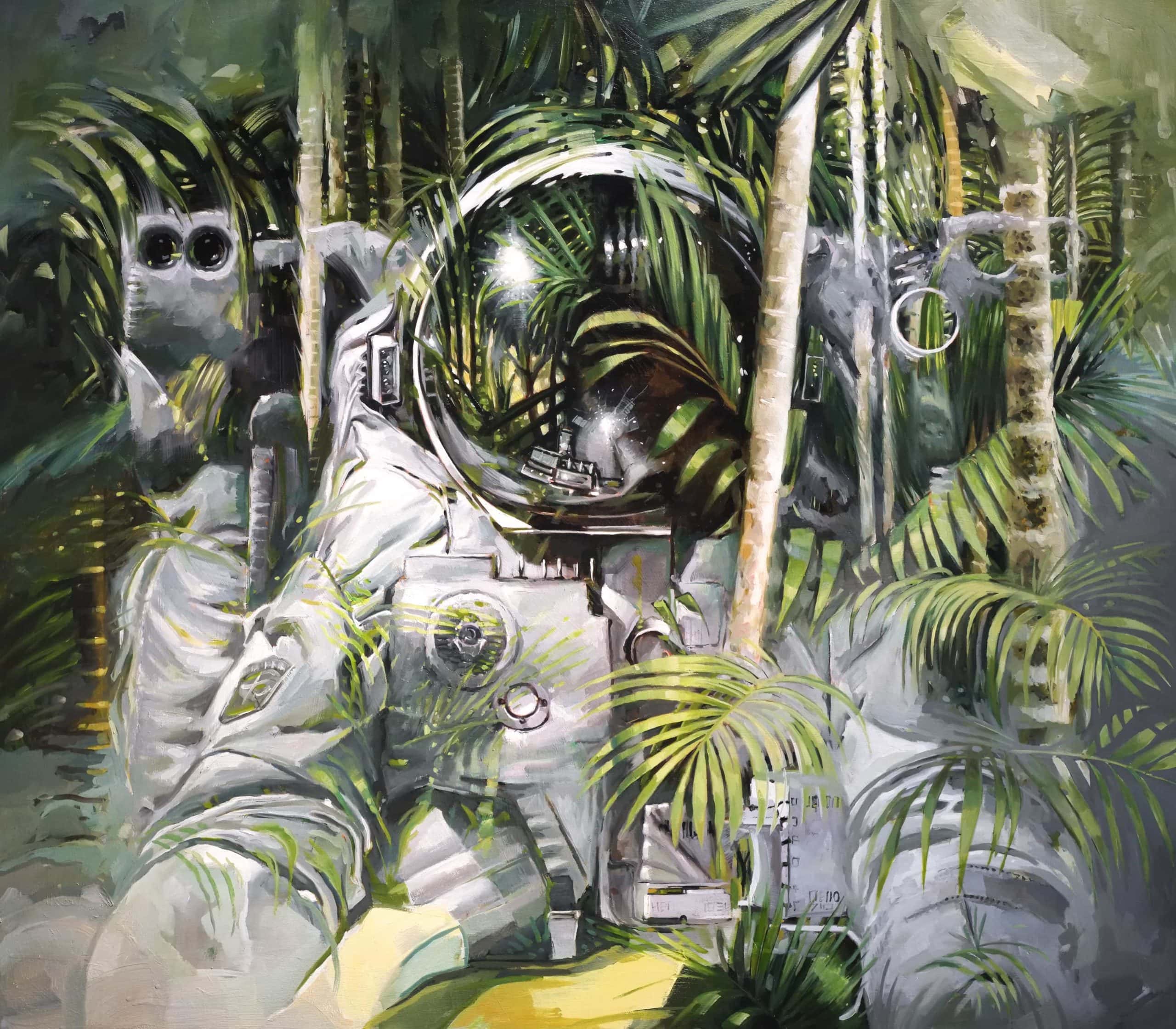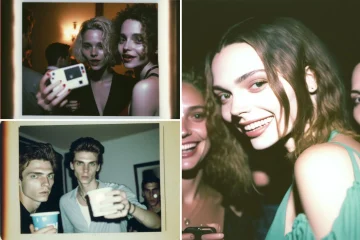

Photography: Christopher Ison, www.christopherison.com. Johnny Morant pictured in his London Studio.
I enter Morant’s home, a place where gravity is loosened – the work from the downstairs studio floating into the rest of the house. But Morant has managed to ground these works, if only for a short time, by hanging them on the living room walls. ‘The Anthropocene’, one of his most impressive pieces, hangs proudly over two lamps, which shaped like birds on a workbench-turned-coffee-table, and a record player.
It’s a spectacular masterpiece of an astronaut breaking through into the world of Jean-Honoré Fragonard. Or, I wonder, is it of the world falling away, as the astronaut floats into an abyss? There are many interpretations and Morant welcomes them all; this artwork is, after all, about getting a reaction from the audience, compelling us to think about the relationship we have with our planet.
Even though this project is a step closer to surrealism than Morant’s previous work, there is no compromise in artistic detail. His work is clearly grounded by a solid foundation of artistic talent. We sit on the sofa, surrounded by his paintings, to mull over his latest exhibition.
This artwork is about getting a reaction from the audience, compelling us to think about the relationship we have with our planet.

The Bigger Picture
So how are you finding living and working in the same space?
The difficulty is you’re always surrounded by your work. It’s always there and I think that’s never a good thing. But the plus side is I can work late into the night – I just keep going until I feel like stopping. Also, I get a lot of feedback. I get the opinions of people who don’t know anything about art and that’s more useful because their reactions are untrained and unrestrained. I would love a big studio but that would mean a small house and I don’t think that’s fair on my wife.
Tell me about the inspiration behind this project.
We are in the age of the Anthropocene, a time when humans are the biggest influence of change on the planet and this project was born out of a frustration with the scant regard, we as a race, give our habitat. We have grown disconnected from nature and therefore do not notice the harm being done as we consume the planet’s resources with little thought for the future.
We are in the age of the Anthropocene. This project was born out of a frustration with the scant regard, we as a race, give our habitat.

The Anthropocene
What is the significance of the astronaut?
The astronauts are the epitome of disconnection with society. They are as far away as they can be, and I wanted to show the disconnection between humans and nature. I discovered this curious thing called the ‘Overview Effect’, which is what astronauts experience from space when they see the curvature of the earth; it’s been reported that every single astronaut who goes up there has the profound epiphany that what really matters is preserving the planet we’re living on. We don’t really have a clear perspective from down here. The astronauts are the ones who do.
The Design Museum’s ongoing ‘Moving to Mars’ exhibition shows astronaut suits being designed to contrast the harsh environments. Seeing your work, makes me feel like they represent a step further, of earth not being liveable anymore…
There’s a lot of messages like that. Initially people look at them and think “has an astronaut found another earth like planet?” Or, “has the astronaut come back to a ruined planet?” I enjoy playing with questions like that. If you bring an astronaut into a lush green environment he’s automatically at odds with his surroundings and it kicks you out of your comfort zone. You have to think “why is this happening? What is the artist trying to convey by creating these unreal situations?” And that’s what I’m trying to do, I don’t really give any answers.

Collision Course
Your previous projects include observational studies of the human form, whereas this project is very much a fantasy. Have you found that liberating to rely on imagination more?
You saying that was the first time I’d ever heard the word “fantasy” used to describe my work, which is interesting because I suppose they are a sort-of fantasy. It’s a real life fantasy. The mechanical parts and the astronaut space suits are all accurate. I liked it because it was a challenge, but it was much harder. Painting from observation is exactly what I’m trying to break away from.
Your painting, ‘The Antropocene’, recently sold through Instagram. What part do you think Instagram plays in being an artist?
It’s an amazing tool. I love it because when I finish a painting the first impulse I have is “maybe I’ll pop it on Instagram” because it gives me a fresh perspective on a piece I’ve spent a long time looking at. And usually taking the photo and cropping it is enough for me to realise that it’s not quite right – it’s not finished yet.

Photography: Christopher Ison, www.christopherison.com. Johnny Morant pictured in his London Studio.
And you get followers who would never have found your work before Instagram. There are teenagers in China and school teachers in Germany. I think Instagram is probably the best thing that has happened for art since I’ve been painting. I enjoy seeing what people say. That’s why when I first posted my piece ‘A Greener Future’ on Instagram I captioned it “what do you see?” A lot of people think it’s underwater, people saw little frogs and toads.
I think Instagram is probably the best thing that has happened for art since I’ve been painting. I enjoy seeing what people say.
I think it could be an astronaut suit discarded and now nature is growing around it showing a time of human domination forgotten – what do you make of that?
I quite like that idea. I love when you see ivy and plants reclaiming a man-made object. My piece ‘Bamboo Forest’ is part of the invasive species – if you get it into a man-made environment it roots really deep. Invasive species was the first thing that I hit on. It’s about plants with a curious story and a story that correlates with humans.

Japanese Knotweed
How long have you been working on this project?
All in all, I believe one year. That’s usually what I do for a project; if I do any more than a year my mind starts to wander, whilst any less is not enough time to really get to grips with the subject.
Can you tell me about your creative process?
I studied graphic design so I’m quite quick on a computer. It’s incredibly useful to be able to create collages, overlap things, crop, and work out compositions. And for the astronaut ones, I’ve even got a model astronaut who I bend into shape.
I photograph him and then superimpose him into these photoshop colleges to work out where he could be. I work in oil, on canvas; it’s all about the pigment for me, because if you have poor quality pigment you’ll lose the vibrancy and the saturation.

A Greener Future
How would you describe yourself as an artist?
I like the expression ‘progressive figurative artist’. Figurative in the sense that you can tell what it is when you look at it. I think representational painting is something I’ll carry on doing forever. I can’t really escape the painting. For me, being an artist is very satisfying – you know what you’re doing and you get a good feeling that you’re doing what you should be doing.
You can see Morant’s exhibition ‘Grounded’ at The Royal Opera Arcade Gallery, 5B Pall Mall, St. James’s, SW1Y 4AN. It runs from today (2nd December) to the 6th December.



